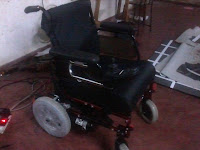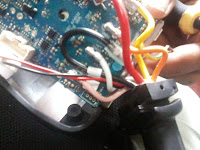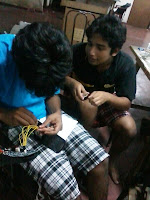The Problem
Our Solution
The thirty-year long civil war in our Sri Lanka left many young and able-bodied men and women with life-long disabilities. The soldiers who fought for the defense of our motherland and civilians caught in the crossfire have suffered grievous injuries that led them to be wheelchair-bound for mobility. However, for some of the most severely injured war heroes, even a wheelchair cannot provide mobility.
On a visit to the longterm-care facility in which disabled officers reside, we could see the particular army officer who has lost all moving functionality below his neck and is only able to move his head. Being a person who always needs an assistant, his only request was to be able to move his wheelchair unassisted by another. In today’s world where people have many complex necessities, his innocent request made us clear the necessity of a solution for the matter.
Then by preliminary investigations it was found that there are already wheelchairs which can fulfill the necessities of people with the disabilities as this particular officer. But it is not atan affordable price in many cases.
Even though we bear eye witnesses only for this person, he is not the only one with this problem. There are many army soldiers and officers in the same condition in Sri Lanka.
Moreover considering about the whole world it has been estimated that there are more than 50,000 individuals who don’t have use of their arms and legs (quadriplegics). Majority of them are war heroes of developing countries as Sri Lanka and they also suffer from the same problem that is even though there are wheel chairs which have been developed aiming this population, most of these people cannot reap the benefits of it, as the prevailing solutions are not affordable.
Our Solution
Basically our Solution is to make a device which can be easily interfaced to any kind of electric wheelchair. So the user can easily convert his/her wheelchair to a wheelchair controlled by head movements and voice commands. Meanwhile our device should be a low cost, durable device.
After interfacing a electric wheel chair with our device the wheelchair can completely controlled by using head movements and voice commands. So basically we can divide the functionality of the wheelchair in to two. They are,
Calibrating
It is obvious that there might be disable persons that the free position of his /her neck is different from a normal person. So when turning the wheelchair to left and right the user may find difficulties. To overcome these problems we have introduced the calibration of the head movement before we start controlling the wheelchair. By this calibration anyone can make their relaxed head position as the stable position of the head movement. Not only that
but by calibrating, the user can change the balance of the turning to left and truing to right control functions.
Emotional Control
When designing this product we have also considered about emotional side of the user. This product is for the disabled person. By this product we will give legs to the disabled person. Sometimes some disabled persons might get frustrated about their life and may try to attempt suicide. In designing this product we have given our first priority to the safety. We have attached the sensors to the wheelchair so that if the user tries to move the wheelchair in to staircases or dangerous slopes it will be detected. If the wheelchair detects a dangerous slope or a staircase very near to the wheelchair it will make noise and stops. In the danger zones the wheelchair will not respond to the user commands. So a helper needs to come and move the wheelchair away from the particular area.
How We Achieved
The overall logic behind this project can be illustrated as follows.
The implementation is done through basically 4 steps.
Step 1 - Identifying the circuits embedded in the wheelchair
Step 1 - Identifying the circuits embedded in the wheelchair
- The wheelchair selected was LYEB103.
- Dissembled the control unit in the wheelchair.
- We identified that a removal of one component will even lead the wheelchair to be locked, to the safety of the user.
- Then we identified the inputs and outputs of the joystick by the means of an oscilloscope.
- We supplied the analog voltages using two variable resistors and deceived the circuit,
- As the prior step was successful we supplied digital values using digital to analog converters.
- ZCT245AN-TTL 2-axis tilt sensor was used, which is connected to the head of the user.
- This can measure the angles with reference to the x axis as well as the y axis of the horizontal plane.
- Through a serial interface the angle measured by the tilt sensor is caught by an Arduino Uno board which contains the driving program of the wheelchair.
- Easy VR, voice recognition shield was mounted on the Arduino Uno board.
- It can be configured to recognize 20 voice commands.
- It generates and sends a signal to the Arduino Uno board according to the command received.
- The commands used are “Power On”, “Power Off”, “Start”, “Stop”, “Speed Up”, “Speed Down” and “Calibrate”.
- According to the head movements
- According to the input signal (which was generated by tilt sensor), Arduino Uno board generates the relevant digital signal.
- Those signals are converted to signals which are analogous to the output signals of the joy stick and given to the relevant ports of the control circuit.
-
According to the voice commands
- The original control circuit uses inputs from switches to control power and speed.
- According to the input signal (which was generated by Easy VR), Arduino Uno board generates the relevant signal.
- The circuit is developed so that the tasks done by switches take place according to the generated signals.
After interfacing a electric wheel chair with our device the wheelchair can completely controlled by using head movements and voice commands. So basically we can divide the functionality of the wheelchair in to two. They are,
- Functionalities controlled by the Voice
- Functionalities controlled by the Head Movements
In this System the User has basically seven word commands. We can adjust them as user want when initializing the voice controlling system. The basic word commands are,
- Turn On : To switch-on the wheelchair
- Turn Off : To switch-off the wheelchair
- Start : To start control of the wheelchair according to head movements
- Stop : To Stop control of the wheelchair according to the head movements
- Speed Up : To increase the maximum speed of the wheelchair movement
- Speed Down : To decrease the maximum speed of the wheelchair movement
- Calibrate : To calibrate and initialize the head movement detection system
Functionalities controlled by the Head Movements
Head movement basically controls the movement of the wheelchair. Here we have introduced for directions that can be controlled by the head. Those basic movements are,
- Go Forward : User has to look up direction
- Go Backward : User has to look down direction
- Turn Left : User has to look left
- Turn Right : User has to look right
Calibrating
It is obvious that there might be disable persons that the free position of his /her neck is different from a normal person. So when turning the wheelchair to left and right the user may find difficulties. To overcome these problems we have introduced the calibration of the head movement before we start controlling the wheelchair. By this calibration anyone can make their relaxed head position as the stable position of the head movement. Not only that
but by calibrating, the user can change the balance of the turning to left and truing to right control functions.
Emotional Control
When designing this product we have also considered about emotional side of the user. This product is for the disabled person. By this product we will give legs to the disabled person. Sometimes some disabled persons might get frustrated about their life and may try to attempt suicide. In designing this product we have given our first priority to the safety. We have attached the sensors to the wheelchair so that if the user tries to move the wheelchair in to staircases or dangerous slopes it will be detected. If the wheelchair detects a dangerous slope or a staircase very near to the wheelchair it will make noise and stops. In the danger zones the wheelchair will not respond to the user commands. So a helper needs to come and move the wheelchair away from the particular area.
A working prototype of this wheelchair can be watched in the following video.
Advantages of Our Device
Advantages of Our Device
- Low cost
The main advantage of this device is, it can be priced at a low price compared to the existing market price. As above mentioned the crucial problem we have identified is, that the people from developing countries are not able to afford to the existing products. - Can be easily interfaced
The device can be easily interfaced to any motorized wheelchair. In some cases it may need small configurations. But even people who are not from technical backgrounds can easily tackle it. - Safety
Even some wheelchairs which are manually controlled are not safe enough, there are possibilities where those can go to slopes, staircases etc. As mentioned above these can be detected through this device, which will increase the level of safety. - Flexibility
The device can be tailor made to the user , by customizing the voice command according to the user requirements.
Our Team
- Dimuthu Upeksha
- Sameera Nilupul
- Chameera Wijebandara
- Milinda Fernando
- Vijayindu Gamage
- Chamila Wijayarathna
- Madhushi Bandara
- Akila Pemasiri



































